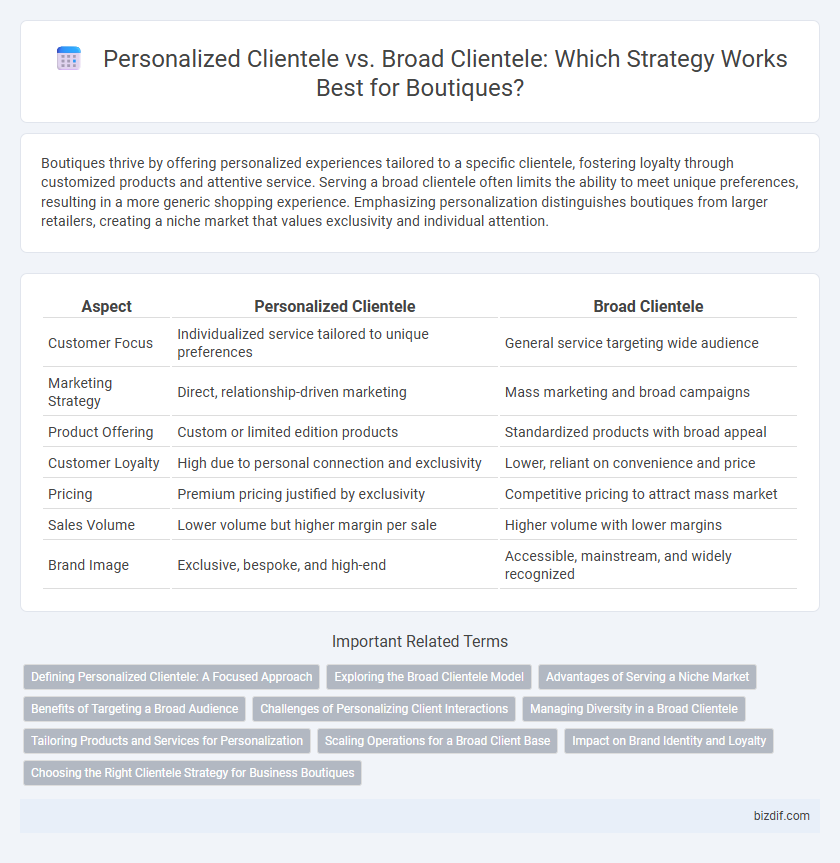Boutiques thrive by offering personalized experiences tailored to a specific clientele, fostering loyalty through customized products and attentive service. Serving a broad clientele often limits the ability to meet unique preferences, resulting in a more generic shopping experience. Emphasizing personalization distinguishes boutiques from larger retailers, creating a niche market that values exclusivity and individual attention.
Table of Comparison
| Aspect | Personalized Clientele | Broad Clientele |
|---|---|---|
| Customer Focus | Individualized service tailored to unique preferences | General service targeting wide audience |
| Marketing Strategy | Direct, relationship-driven marketing | Mass marketing and broad campaigns |
| Product Offering | Custom or limited edition products | Standardized products with broad appeal |
| Customer Loyalty | High due to personal connection and exclusivity | Lower, reliant on convenience and price |
| Pricing | Premium pricing justified by exclusivity | Competitive pricing to attract mass market |
| Sales Volume | Lower volume but higher margin per sale | Higher volume with lower margins |
| Brand Image | Exclusive, bespoke, and high-end | Accessible, mainstream, and widely recognized |
Defining Personalized Clientele: A Focused Approach
Personalized clientele in boutiques refers to a carefully curated group of customers whose unique preferences, styles, and needs are intimately understood and catered to, enabling tailored product selections and exclusive services. This focused approach allows boutiques to foster strong relationships, enhance customer loyalty, and offer a distinctive shopping experience that broad clientele strategies cannot match. Emphasizing quality interactions and customized offerings, personalized clientele creates a niche market advantage crucial for boutique success.
Exploring the Broad Clientele Model
The broad clientele model in a boutique setting targets diverse customer segments, expanding market reach and increasing sales volume. This approach leverages versatile product offerings and scalable marketing strategies to appeal to a wide audience rather than focusing on niche customization. Brands employing broad clientele tactics benefit from higher brand visibility and potential economies of scale in operations and inventory management.
Advantages of Serving a Niche Market
Serving a niche market allows boutiques to offer personalized, tailored experiences that foster strong customer loyalty and higher client satisfaction. By focusing on a specific clientele, boutiques can optimize inventory, marketing strategies, and product selection to meet unique customer preferences more effectively than broad-market competitors. This targeted approach often results in higher profit margins and a stronger brand reputation within the specialized segment.
Benefits of Targeting a Broad Audience
Targeting a broad clientele allows boutiques to maximize market reach and increase overall sales potential by appealing to diverse consumer preferences. Expanding product offerings to suit various demographics enhances brand visibility and fosters customer acquisition from multiple segments. This strategy also supports economies of scale, reducing per-unit costs and improving profitability.
Challenges of Personalizing Client Interactions
Personalizing client interactions in a boutique setting poses challenges such as managing diverse preferences while maintaining efficiency and consistency. Limited resources often restrict the ability to offer tailored experiences at scale, complicating the balance between exclusivity and customer volume. Data collection and analysis become crucial to understanding individual needs without compromising privacy or overwhelming staff.
Managing Diversity in a Broad Clientele
Managing diversity in a broad clientele requires boutiques to implement tailored customer segmentation strategies that address varied preferences, cultural backgrounds, and purchasing behaviors. Effective use of data analytics and CRM systems enables personalized marketing campaigns while maintaining scalability. Training staff in cultural competence and inclusive communication enhances client engagement and satisfaction across diverse demographics.
Tailoring Products and Services for Personalization
Tailoring products and services for a personalized clientele enhances customer satisfaction by addressing unique preferences, fostering loyalty through customized experiences. Boutiques focusing on broad clientele often prioritize scalable offerings but may lack the intimacy and specificity that personalization brings. Leveraging data-driven insights allows boutiques to create targeted product lines and bespoke services, increasing value and engagement for personalized customer segments.
Scaling Operations for a Broad Client Base
Scaling operations for a broad clientele requires robust inventory management systems and automated customer service platforms to handle diverse preferences efficiently. Employing data analytics can optimize supply chain responsiveness and tailor marketing strategies at scale, ensuring consistent customer satisfaction. Streamlined workflows and scalable technology solutions are essential to maintain service quality while expanding reach beyond a personalized boutique experience.
Impact on Brand Identity and Loyalty
Personalized clientele fosters a strong brand identity by creating unique, tailored experiences that resonate deeply with individual customers, enhancing loyalty and word-of-mouth referrals. Boutiques targeting a broad clientele risk diluting their brand identity, as generic offerings may fail to build meaningful connections or long-term loyalty. Emphasizing personalization drives higher customer retention and reinforces a distinct, memorable brand presence in competitive markets.
Choosing the Right Clientele Strategy for Business Boutiques
Selecting a personalized clientele strategy allows boutiques to build strong customer loyalty through tailored services and exclusive product offerings that resonate with niche markets. In contrast, targeting a broad clientele emphasizes volume and brand recognition by appealing to a wider audience with diverse preferences. Boutique businesses should evaluate market demographics, brand identity, and resource allocation to determine whether a specialized or mass-market approach best aligns with their growth objectives.
Personalized Clientele vs Broad Clientele Infographic

 bizdif.com
bizdif.com